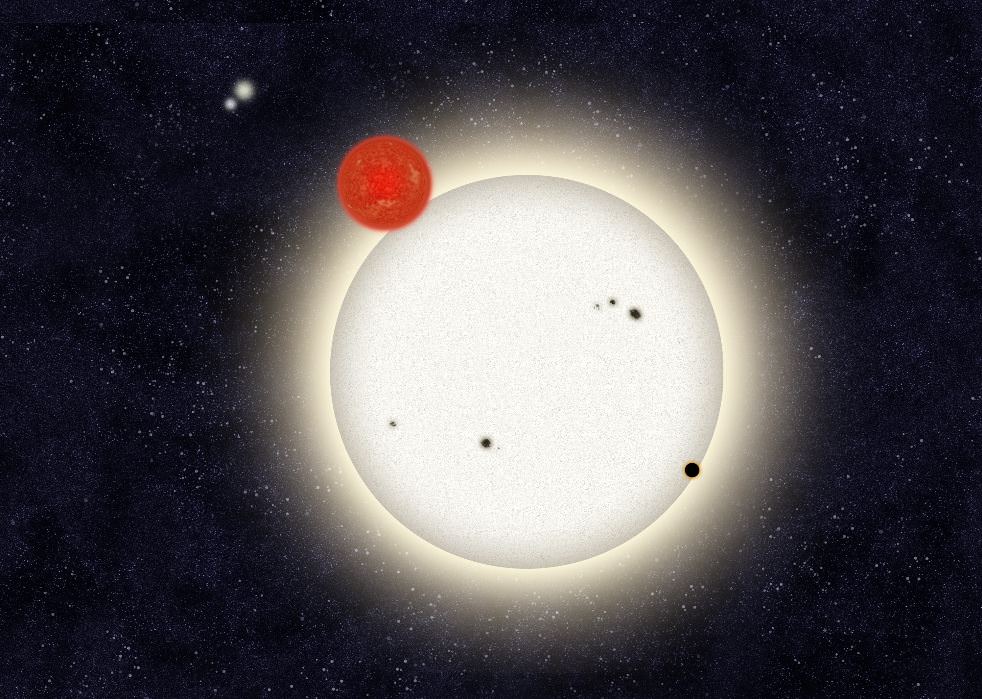A family portrait of the PH1 planetary system: The newly discovered planet is depicted in this artist’s rendition transiting the larger of the two eclipsing stars it orbits. Off in the distance, well beyond the planet orbit, resides a second pair of stars bound to the planetary system. Image Credit: Haven Giguere/Yale.
A planet has been discovered orbiting in a four-star system — and no, that doesn’t mean the accommodations and conditions are excellent. It literally means four stars, where a planet is orbiting a binary star system that in turn is orbited by a second distant pair of stars. This is the first system like this that has ever been found, and its discovery demonstrates the power of citizen scientists, as it was found by a joint effort of amateurs participating on the Planet Hunters website under the guidance of professional astronomers.
This is might be an extremely rare planetary setup, astronomer Meg Schwamb from Yale says, as only six planets are currently known to orbit two stars, and none of these are orbited by other stellar companions. Astronomers are calling the newly found world a ‘circumbinary’ planet.
“Circumbinary planets are the extremes of planet formation,” said Schwamb, Planet Hunters scientist and lead author of a paper about the system presented Oct. 15 at the annual meeting of the Division for Planetary Sciences of the American Astronomical Society in Reno, Nevada. “The discovery of these systems is forcing us to go back to the drawing board to understand how such planets can assemble and evolve in these dynamically challenging environments.”
The planet is called PH1, for the first confirmed planet identified by the Planet Hunters citizen scientists, but it has the nickname of Tatooine, the planet in Star Wars that orbited two suns.
Planet Hunters uses data from the Kepler spacecraft, specially designed for looking for signs of planets.
The volunteers, Kian Jek of San Francisco and Robert Gagliano of Cottonwood, Arizona, spotted faint dips in light caused by the planet as it passed in front of its parent stars, a common method of finding extrasolar planets. Schwamb, a Yale postdoctoral researcher, led the team of professional astronomers that confirmed the discovery and characterized the planet, following observations from the Keck telescopes on Mauna Kea, Hawaii. PH1 is a gas giant with a radius about 6.2 times that of Earth, making it a bit bigger than Neptune.
“Planet Hunters is a symbiotic project, pairing the discovery power of the people with follow-up by a team of astronomers,” said Debra Fischer, a professor of astronomy at Yale and planet expert who helped launch Planet Hunters in 2010. “This unique system might have been entirely missed if not for the sharp eyes of the public.”
PH1 orbits outside the 20-day orbit of a pair of eclipsing stars that are 1.5 and 0.41 times the mass of the Sun. This planet is dense — it has perhaps about 170 times more mass than Earth — and is about half the diameter of Jupiter. It revolves around its host stars roughly every 138 days. Beyond the planet’s orbit at about 1000 AU (roughly 1000 times the distance between Earth and the Sun) is a second pair of stars orbiting the planetary system.
Gagliano, one of the two citizen scientists involved in the discovery, said he was “absolutely ecstatic to spot a small dip in the eclipsing binary star’s light curve from the Kepler telescope, the signature of a potential new circumbinary planet, ‘Tatooine,’ and it’s a great honor to be a Planet Hunter, citizen scientist, and work hand in hand with professional astronomers, making a real contribution to science.”
Jek expressed wonder at the possibility of the discovery: “It still continues to astonish me how we can detect, let alone glean so much information, about another planet thousands of light years away just by studying the light from its parent star.”
Source: Planet Hunters

